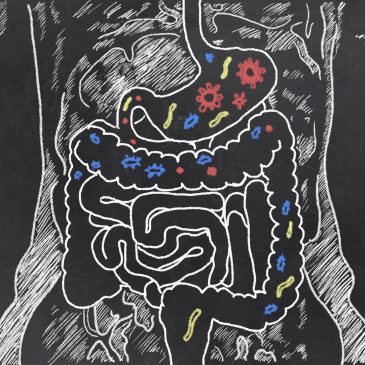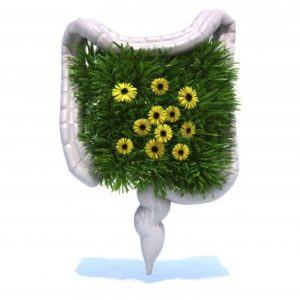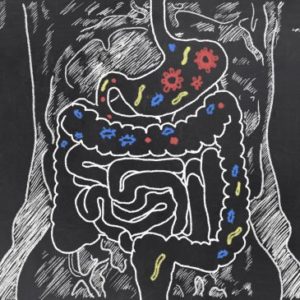Po(o)p quiz
What bit of your body, if you ironed it out, would be 7km long and cover a surface area of between 250-400m squared?
It’s your….Small Intestine (SI).
When I hear these things, I think to myself, where does it all fit?
Excellent question Marnie!
It’s all those lovely folds down there that make it so compact and squishy and beautifully designed. If we didn’t have those folds, the small intestine would have to be about 18 metres long.

Fascinating gut facts
It’s approximately nine metres from your mouth to your bum.
Over a lifetime, about 60 tonnes of food will pass through you.
It’s roughly a 50 hour journey (but may vary from 24-72 hours) from eating food to pooing it out (although a good curry may speed up that process!).
There are approximately 50 million bacteria per teaspoon of small intestine juice (relatively sparse compared to the large intestine).
The surface area of your digestive system is about 100 times greater than your skin.
So what does the SI do?
The surface of the SI is covered with tiny hair like projections (about 30 per square mm) called villi. These villi help us absorb nutrients into the bloodstream.
As soon as we eat, our liver and pancreas start making enzymes to soak our food as it passes through. This enables us to be able to digest our macro-nutrients – carbohydrates, proteins and fats.
If you don’t make enough stomach acids or produce enough enzymes, food particles can’t get broken down properly in the SI. This means that you start to provide TOO MUCH sustenance for non-beneficial gut bacteria and also prevents the absorption of essential nutrients.
The intestinal wall is where most of our nutrients are absorbed and consumes about 40% of all of your body’s energy. It also prevents allergens, microbes and toxins from entering the interior (think of yourself as a tube from mouth to anus).
Some symptoms of a ‘dodgy’ gut.
- Weight gain
- Bloating
- Food cravings
- Constipation
- Diarrhoea
- Candida/thrush
- Irritable bowel syndrome
- Cramps/discomfort
- Fatigue
- Skin problems
- Depression – yes that’s right! You have as much of the feel good neurotransmitter, serotonin, in your gut as you do in your brain.
Are you doing this daily?
 We’re now approaching the end of our 50 hour journey folks. Last stop before the S-bend. All aboard!
We’re now approaching the end of our 50 hour journey folks. Last stop before the S-bend. All aboard!
The large intestine (LI) or colon, is much smaller in length than the small intestine (SI), measuring roughly 1.5 metres. It gets its name from its width, about 10cm.
Once food gets to the LI, it moves at a snails pace and hangs around for about 16 hours. What wasn’t digested in the SI happens here. For example, calcium is digested in the LI. It also helps you with an extra serving of:
- Vitamin K – helps the blood to clot
- Vitamin B12 – strengthens your nerves
- Vitamin B1 – makes you smarter
- Vitamin B2 – helps prevent migraines
Compared to the SI, the colon is teeming with microbial activity. If you were to take a teaspoon of juices from there, you would find approximately…wait for it….500 BILLION CELLS (I feel like Austin Powers) with close to 1000 species of bacteria!!!
Sad note
We Westerners, with our processed diets and sterilised homes, are losing species variety in our bodies. For example, the average Westerner has around 1200 varieties of microbes living in and on them. Compare that with those living in more traditional societies – around 1600!
Our current diet is starving our gut bacteria because we don’t provide them with enough good quality leftovers to feed on.
I think you can guess by now what you should be doing on a daily basis (at least). It’s a…
POO
Fascinating stools:
Poo is 75% water.
During the whole digestive process, close to 10 litres of water are reabsorbed.
1/3 of the solid components are made-up of bacteria.
1/3 insoluble fibre – the more fruit and veges you eat the more poo you do, from 100-200gms – 500gms (that’s a good thing – we all know that head clearing, satisfying, oh my goodness it’s going to be a good day poo!).
1/3 mixed bag – this is the leftovers of medicines, food colourings and cholesterol.
Colour – should be browny-yellowish (not too yellow). The colour comes from the 2.4 million red blood cells we break down every day (don’t worry, we make the same amount up daily).
A good poo is a very important thing. Next time you ‘drop the kids off at the pool’, turn around at take a good look. Compare it with the Bristol stool chart. Aim to be type 3 or 4.
How to love your guts
If you’ve been feeling more Bloaty McBloatface than usual:
- Keep a diet diary for a week – notice any trends? Email me for a fillable diet diary so you can track all that goes in and out and through.
- Try cutting out gluten for a week and see if that makes a difference – you’d be surprised how many people report back that this simple tip makes a significant difference.
- Consider doing a 4-6 week Gut Reset. I’ve been running this successful programme in my clinic for over a decade and now that the weather is getting warmer, it’s the perfect time for a ‘tidy up’. Get in touch to find out more.
- Manage your stress – you have as much of the feel good neurotransmitter, serotonin, in your gut as in your brain.
- Download the Insiders’ Guide – Bloaty McBloatface. It’s filled with practical magic and actionable steps for you to help ban the bloat for good (and comes with a consult with me to help get you started).
Next time I’m going to give you the secret to long term health and happiness… (my version at least)
Until then, you know what to do. Keep being Great.
Marnie
P.S If you haven’t already done so, make sure you download your FREE Survivor’s Guide to Menopause (did I say it’s free?).
P.P.S If you know someone who is struggling with all the changes, please share this with them.
